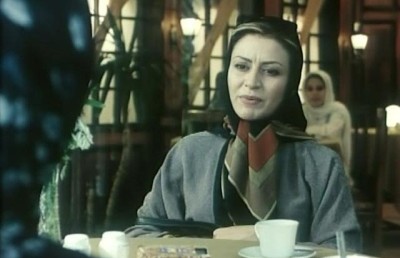The Neighbor: Naghmeh Shirkhan’s Choreography of Iranian Women’s Life in Migration

The Neighbor is the half-told story of 5 women: Shirin (Azita Aahebjam), her mother and grandmother; and Leila (Tara Nazemi) and her daughter Parisa (Parisa Wahedi). The Neighbor is an exploration of love; a rare glimpse at what it means for single ‘emancipated’ Iranian women who live outside Iran. The film explores love from multiple facets; raising questions about fidelity, guilt, and importantly, alienation. Yet, it contextualizes the questions within the lives of women who are capable of beauty, courage, creativity and hope. The lives of Iranian immigrants in their new American and European homes are rarely projected on screen. [1] In The Neighbor, director Naghmeh Shirkhan takes a brave leap into a prevalent, but rarely mentioned reality of Iranian women’s lives in ‘exile’. Shirkhan’s film simply asks: “how liberated is an Iranian woman, who breaks from the traditions of home?”
The film has three equally important protagonists; each occupying the same screen time. Shirin, is a beautiful middle aged single woman who runs a dance class for a living and takes ballroom dancing lessons for leisure. Leila is a beautiful young woman, jobless and depressed, in what seems like a temporary home which she shares with her 6-year old daughter, Parisa, while her husband works and sends money from Iran. Parisa is the patient child, who loves drawing and dancing, and lovingly endures her mother’s absence, while trying to reach out for love through the locked door of their apartment. During The Neighbor we develop curiosity about what motivates these three, but we are hardly given an answer. For this reason, The Neighbor keeps working offscreen, in the minds of many a women who did approach the director, after its premier at the Montreal Film Festival, to tell her she had told their story; their mother’s or daughter’s story.
The first actor, Shirin seems to be in an unhappy affair with a married middle aged Iranian man (why else would they meet in hotel rooms or parking lots in the middle of nowhere?). Despite her affair, Shirin doesn’t seem to love anyone. She even walks out of her relationship without a word explained. Nevertheless, she is nice to everyone; she speaks little, but feels a lot. Her one, well-expressed sentiment, is melancholy for her grandmother. Apparently, her mother had abandoned her with the grandmother as a child—presumably to pursue an acting career. This seems to be the point of tension in the family; as her mother leaves messages complaining that Shirin doesn’t call; and the grandmother complains that Shirin’s mother doesn’t call! Shirin’s monotonous life changes when she discovers she lives next door to an Iranian woman, Leila.
Leila is young, proud and beautiful. Leila too seems to have an affair, with the blond guitarist of the bar she frequents. Shirin encounters Leila for the first time through the window, glimpsing a little row between a very young couple: the boy, whose name we learn towards the end of the film when he is introduced to Parisa’s daughter, Randy (Matt Deane) calls Leila “Difficult”. Leila is indeed difficult. When Shirin encounters her for the first time in the corridor of their apartment, she is highly reluctant to introduce herself or shake hands. Leila’s manners are completely opposite to Shirin’s. Leila does not pretend to any nicety or care. But, Leila cares about her marriage as she often plays with her wedding ring; and is bothered by guilt when in bed with her boyfriend. All we know from Leila’s husband, who can hardly reach her on the phone, are his worried phone calls. We meet him in a family picture in Leila’s home. Judging from his conversation with Leila, they are a loving family. Leila is paradoxical: she is mean and rough to her lover but gentle and understanding with her on-the-phone husband. Her appearance and demeanor are wealthy but her home is poor; cold and undraped, her daughter is often hungry because she has forgotten to buy food. Her daughter is often lonely because Leila is out. We never know why she has to go out, even when her daughter is burning in fever; and to a desperate point that Leila is forced to ask Shirin’s help. This is where the relationship between “the neighbors” begins.
The third main character of the film is Parisa. She is 6 years old. She is still not registered in school. She is often alone at home, and no one knows that (until Shirin discovers). She is obedient of her mother who has ordered her to not speak to strangers. Parisa is hungry for attention and for playing. When Shirin can finally convince Leila to let the child out, Parisa develops an immediate bond with Shirin; so much so that she wants her to wear Leila’s beautiful dress and makeup. Leila misses her father. Like all children, she is creative and has a temple for her toys and a shrine for her family memorabilia, mostly pictures that she collages on cardboards. She is a creative, loving and smart child. Smart enough to realize her mother’s relation with an unknown man, but tactful enough to not ask further when refused an answer once. It seems, she is also the source of contention between Leila and her boyfriend. He is least accommodating of Leila’s responsibilities as a mother, to an extent that he abandons them in the middle of the road when Parisa gets hungry after an outing. Parisa is central to Leila’s dilemma: “will she runaway with her lover, when Parisa finds safety in Shirin’s motherly arms?”
Three themes are omnipresent in The Neighbor: betrayal, guilt and alienation. Here, all characters, except the youngest and the eldest seem afflicted: Shirin sleeps with a married man in hotel rooms; Shirin’s mother has abandoned her and her grandmother; Leila cheats on her husband and neglects her child; Shirin’s luxury-living friend and the band of her giggly party-throwing friends betray the old mother visiting from Iran (by giving her a panoramic room on top of a high-rise, negligent to her fear of heights). But there is guilt too. As far as their love affairs, both Leila and Shirin seem to be the passive executioners of their men’s desires. When the men are blissfully asleep in the post-love bed, the two women slip away in the middle of the night, to go back home.
The sin and the guilt compound their alienation: both Leila and Shirin are incapable of communicating with their community; however they seem unable to escape it. Shirin cannot explain to her dance students why she does not want a man or a child; but she cannot refuse their invitation to the party either—although she sneaks away. Shirin’s boyfriend finds her in her ballroom dance class and obliges her into a dance. Her nicety stops only when his persuasion intensifies; thus she slips out of his arms running into the cold streets of night. Leila too is escaping that which is familiar. The frame in which Shirin corners her against a “no exit” door, and forces her to handshake, speaks clearly about Leila’s reluctance to make an Iranian acquaintance. Even after she recruits Shirin to babysitting for her, she cannot muster an apology for not showing up all night. Instead, she offers her money!
Despite being evasive in their own community, both Leila and Shirin seem unable to ‘fit’ in the new world. In the dance class, Shirin is the last to find a partner for a dance (unless if the teacher asks); in the bar where Leila’s boyfriend plays, she is an outsider to the happy band. They both feel awkward and displaced. In fact, both Leila and Shirin appear unhappy through most of the film, except for occasions that they interact with the child, or dance (alone).
Nevertheless, The Neighbor is not an unhappy film. It is not a film about victimhood (to which Iranian women of screen are often accused, or of which they escape). It is not a film about blame, sympathy, nor about action and resolution. It is a slice of life that many Iranian women identify with: it’s about motherhoods and daughterhoods interrupted or entangled in intricacies of migration and cultural alienation. It is a reflection on home, on safety, and on solitude. Watching the film, you are not asked to judge or to understand, but to share, to feel. This is thus a sensual film. Although it is a rare suggestion of an Iranian woman’s sexuality, but that is set as a backdrop for highlighting cultural and personal dilemma. The sensuality of the film comes from the many close-ups on food, prepared Iranian style; on make-up worn by older and younger women, and the womon-to-be, Parisa; on hands that touch or refuse touching, on ankles that dance, the waist lines that are held, the feminine curves that move to a modest traditional music, the dresses that cover them gently, the camera gazing.
This sensualization of women’s role, abstraction of their body parts or movements, makes them into props; their character is visible, yet their function and purpose somewhat open to interpretation, to intersubjectivity, but also to voyeurist’s gaze. Shirkhan considers most of on-screen women of Iranian films too dramatic, her protagonists are thus intentionally minimalist in every sense. For a director who wishes her film to be seen by as many people who can take pleasure from a good film, [2] she achieves to take her spectators on an almost two hours scopophilic ride; letting ‘them’ decide what pleasure or self-identitification they want to take home at the end.
In the question and answer session that followed the opening of her film in Montreal’s International Film Festival (August 28, 2010), in response to the lauding comments of a spectator who commented on the “language of dance,” Naghmeh Shirkhan confirmed that dance was an important part of her story because it gave the film the sensuality that made it accessible to all. In a later email-interview she wrote “Dance is an integral part of Persian culture. [3] I couldn’t make a film about Iranian women and not have dance be a part of it. It was a wonderful way to contrast the immobility the two women felt in their lives. They felt stagnant, and yet they both danced…one for a living, the other danced on ice as a means of temporary escape.” But dance also works as a cultural identifier. Through the aesthetics of Shirin’s Persian dance, Shirkhan introduces her protagonist within her own native cultural context, and then, by showing her graceful movement in the ballroom, juxtaposed with the fact that she was not asked to dance often—indicates her capability to integrate and her failure to be integrated. In contrast, Leila’s confusion also correlated with her dance-abilities: she did not know Persian dance (although in private she danced with her daughter, a metaphor for her unease with her native culture) and although she frequently tried (metaphor for her wish to assimilate in the Canadian culture), she was still stiff in spinning on her ice-skates. Nevertheless, dance was a source of solace for both women, and a place of encounter, a meeting point where Shirin and Leila’s 6-year old daughter met eye to eye and bonded. This bonding with the dance also happened amongst the spectators.
Undeniably, dance was the most distinctive element of the mise en scene. Other elements were intended to be minimalist. The lighting was intended to make the film look natural, yet it still felt stylized. The film alternated between two color hues: cold and green; hot and yellow. The dance rooms (both where Shirin taught Persian dance and where she learned Western dance) are warmly coloured; the hotel rooms where the couple have made love are warmly colored; the night-streets along which Shirin and Leila run-away from their lovers are warmly colored; and when Leila takes her child to the park, it is sunny. But the homes of both women are cold and depressive.
Within the limitations of the lighting and filming equipment (Sony EX3), Shirkhan also stylized the shots. Interestingly, in many occasions the film did not “look” digital, therefore one is likely to be puzzled about the inconsistency of shots: at times camera moves fast and smooth as if on a dolly (for example when Leila carries the hungry and tired Parisa in the middle of the night, looking for a restaurant to feed her); at other times it moves nervous and jittered on a close-up as if filmed with a hand held camcorder (for example when Shirin is doing the dishes after getting rejected by Leila). The camera, however, functioned in a subliminal way: it made characters feel intimate. Intimacy to these characters is one of the most capturing features of the film: it is the reason why the passage of time during the screening is impalpable, despite its slow rhythm and lack of action and dialogue. [4]
Credit for shot design, camera angle, duration of a shot and camera trajectory should go to Shirkhan, who had prepared sketches and storyboards for every shot, over a span of three years that she had worked on the script. She has an education in cinema and many years of experience in photography. When asked about the intentionality of cinematography, she stated: “I’ve done a lot of camerawork and photography and so framing and choreographing shots came naturally to me. We spent a lot of time practicing the movements before each take. The fact that the camera operator was a woman certainly helped. I should also add that Armaghan has a very close relationship with the actresses. She is Azita’s younger sister and Tara’s aunt! She was tireless in trying to give me exactly what I wanted. I loved working with a camerawoman.” Nevertheless, the subliminal aesthetics of the shooting may be credited to Armaghan Sahebjam’s several years of experience as a wedding photographer in Vancouver and her familial relation to protagonists. Perhaps without this intimacy, it would not have been possible for a first-time cinematographer and first-time actors to provide such a superb performance. The audience in the Montreal Film Festival almost gasped and aimed a standing ovation when they realized that this was the first stage performance of the actors. In fact, Azita (Shirin) was too stage-nervous to talk. Iranian cinema is defined by the mastery of directors who capture undiscovered talent and extract the intended image. As a first time experience, the ability of Shirkhan to direct non-actor Iranian women, in such a delicate story about the Iranian women in Diaspora, is commendable.
It is thus not surprising that Shirkhan, a relatively unknown editor in New York with experience in “editing everything under the sun”, would conjure the support of two of the most original and avant-garde artists: Amir Naderi, the creator of one of the earliest masterpieces of Iranian cinema, The Runner (1985); and Mohsen Namjoo, [5] one of the most creative musicians Iran has produced in recent years. Naderi co-produced the film with Shirkhan and Namjoo provided its original score. In a video interview, talking about the film, Namjoo stated that what caught his attention about The Neighbor was the fact that Amir Naderi was going to produce it: “It must be great, if Mr. Naderi has given it endoursement,” he said, “but despite all its cinematic achievements, about which I am not an expert, what captured me was the dignity and the sincerity of the film and its people, I tried to convey that dignity in the music I made for the film.” Although both Naderi and Namjoo were present at the opening of the film in Montreal film Festival, the star of the evening were Shirkhan and her three female protagonists: Parisa, Shirin and Leila (mother and daughter.) In fact, Namjoo, a rock-traditionalist musician of unmistakably distinct style, had achieved his aim of blending his music with the gentle rhythm of the film, its plot and the characters; so much so that it did not have any excessive nor prop effect. The film also did not resemble any of Naderi’s work, which often accentuate the rough edges of life against the vulnerabilities of the flesh of a sole man, as he does in The Runner (1985), or in Manhattan by Numbers (1993).
A fan of Godard, Varda, Fellini, Antonioni, (early) Truffaut, Garrel, Rivette, and Naderi (although not at all the same) she aspires to tell her stories without artistic compromise. When asked about intentions of film and her audience, Shirkhan responded that he wished to make a film for anyone who appreciated a good film and made something that even her two young sons could watch multiple times. She made a film to appeal to a wide audience. Despite the film being in Persian, the dialog was made so minimal that one could figure it all out without subtitles. Although she left Iran when she was five, her visual memory of Iran is vivid. She has recently begun going back home and the video shots of Iran have been invaluable in conceptualizing The Neighbor. The characters in the film are inspired from women she has known: her mother, her grandmother, her mother’s closest friends. All strong, willful, independent and a bit lost; caught between two very different worlds. Yet, Shirkhan intends her film to be universal: “Women all over the world share the same inner struggles, and we’re all searching for meaning in our lives. Some of us have the added baggage of having to live far from our families and homelands, but ultimately we have to make a decision to adapt and move forward. I think this film is a modern story that will resonate with many people of different backgrounds.”
PS: This film was screened at the 2010 Montreal World Film Festival.
Essay was submitted by October 2010.
Endnotes
1 Besides The House of Sand and Fog (2003), a Hollywood production documenting the sorrows of an ailing Iranian couple, the only previous film about Iranians in Diaspora was a Swedish film All Hell Let Loose (2002), by Sousan Taslimi, where the alienation of an Iranian family, especially the mother’s and the daughter’s struggle to find their place in their new society was presented in a comedy-drama.
2 The filmmaker was interviewed via a few emails about her inspirations for the film.
3 I should clarify that dance is an integral part of Iranian socialization and folklore but a highly neglected aspect of the Persian culture. It is hardly researched, and taught methodically. Especially, after the Islamic Revolution of 1979, all state-sponsored dance education and exhibitions have been forbidden. It is only in recent years that the Iranian community ‘in exile’ has taken an interest in introducing Persian dance in its folkloric context. This film is also the first introduction of Iranian dance on the silver screen. Inside Iran, rare attempts have been made to integrate dance in theater; however moving to a rhythm in public remains an objectionable act in the fundamentalist Islamic views.
4 Namjoo speaks of the 160 minute uncut version of the film that felt one hour shorter than he thought.














